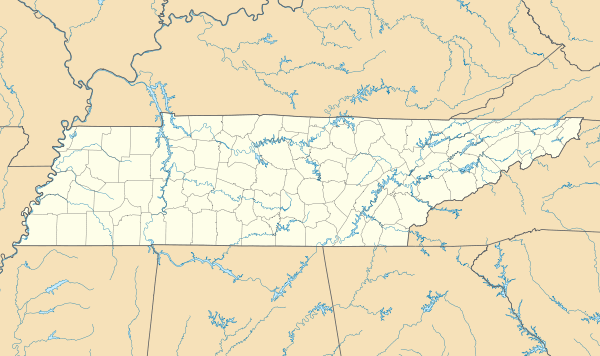Stone Hall, Nashville
|
Stone Hall | |
|
Stone Hall in 2014 | |
  | |
| Location | 1014 Stones River Road Nashville, Tennessee, US |
|---|---|
| Coordinates | 36°11′17″N 86°37′59″W / 36.1880°N 86.6330°WCoordinates: 36°11′17″N 86°37′59″W / 36.1880°N 86.6330°W |
| Built | 1918 |
| Architectural style | Colonial Revival |
| NRHP Reference # | 10000923[1] |
| Added to NRHP | November 17, 2010 |
Stone Hall is a historic mansion in Nashville, Tennessee, US. It was designed in the Colonial Revival architectural style.[2] It has been listed on the National Register of Historic Places since November 17, 2010.[2][3]
The hall was designed by architect George D. Waller (1883–1969) of Nashville. Waller is also credited for designing various schools in Tennessee, Kentucky, Alabama, and Georgia. He is well known in Nashville for his classical designs, and in the words of Christine Kreyling “one of the last of Nashville’s architects with a thorough grasp of the ethos of the Grecian style.”[4]
The Stone Hall was built in 1918 for the Cantrell family, Dempsey Weaver Cantrell (1880–1965) and Nora Johnson Cantrell (1882–1959). The couple married in 1907. Nora Johnson Cantrell was a poet, and was named Poet Laureate of the Tennessee Federation of Women’s Clubs in 1939. Dempsey Weaver Cantrell was a businessman. He founded a wholesale paper goods company named Southern Woodenware Company in 1903. Before moving to Stone Hall, the Cantrell family lived in East Nashville in a house on Russell Street.[5] Following the 1916 fire of East Nashville in which their street house was "just missed", they decided to shift their home to a suburban area of Nashville. Nora Cantrell's father owned some land in the Donelson area, and the Cantrell family decided to build their new home here. They met architect George Waller, who ended up designing Stone Hall.[4][6]
The Metropolitan Government of Nashville and Davidson County and Greenways of Nashville acquired Stone Hall in 2006–07. Hall is now used for public events and can be hired for weddings, receptions and cultural programs.[4][7]
References
- ↑ National Park Service (2010-07-09). "National Register Information System". National Register of Historic Places. National Park Service.
- 1 2 "Stone Hall". National Park Service. Retrieved January 12, 2016.
- ↑ Robert Brandt (22 November 2013). Natural Nashville: A Guide to the Greenways and Nature Parks. iUniverse. pp. 72–. ISBN 978-1-4759-6086-0.
- 1 2 3 "Stone Hall History" (PDF). nashville.gov.in. Retrieved 12 January 2016.
- ↑ Edwards, Amelia Whitsitt (1999). Nashville Interiors, 1866 to 1922. Mount Pleasant, South Carolina: Arcadia Publishing. p. 91. Retrieved January 13, 2016.
- ↑ "Stone Hall". Metro Government of Nashville and Davidson County, Tennessee. Retrieved January 12, 2016.
- ↑ "Historic Stone Hall" (PDF). nashville.gov. Retrieved 12 January 2016.